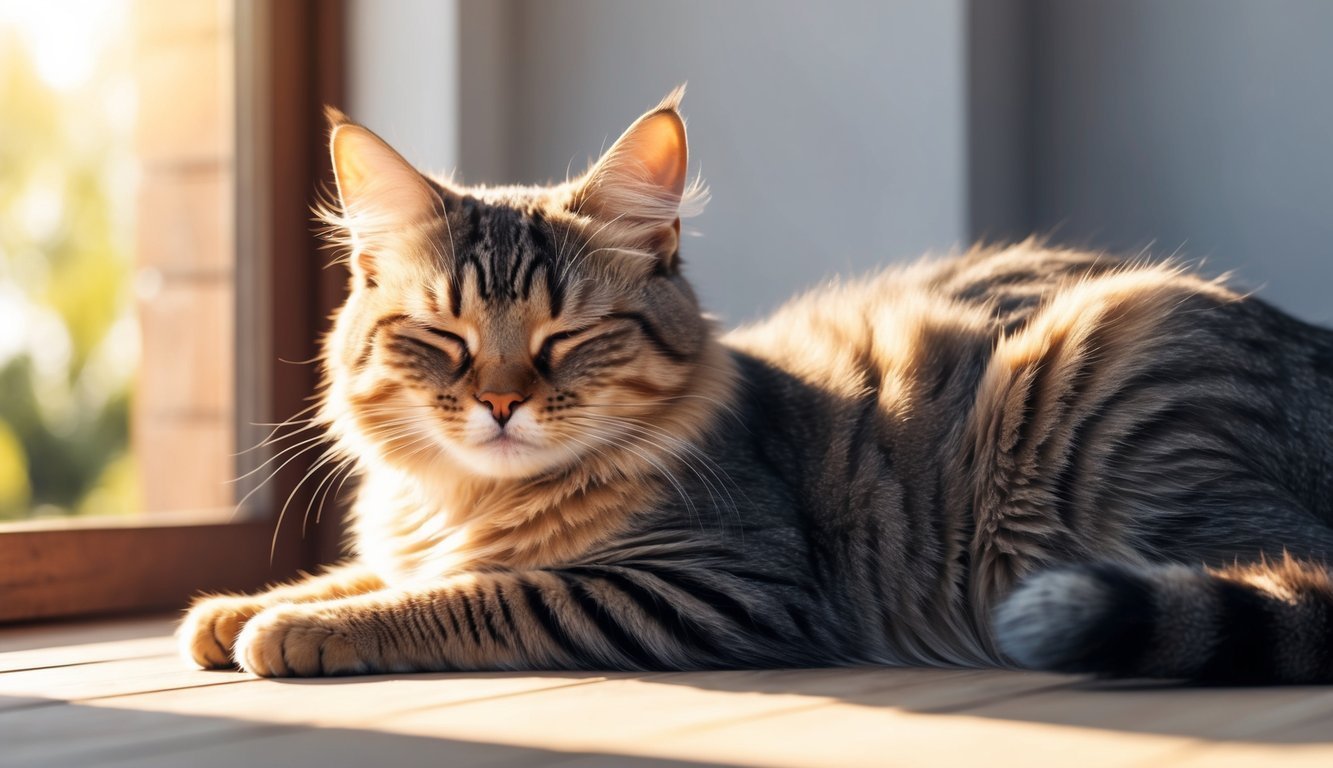Cats communicate their feelings through their ears, and when those ears feel warm, it can be concerning for any cat owner. Warm ears in cats can be a sign of various factors, ranging from normal physiological responses to potential health issues. Understanding why your cat’s ears are warm can help you decide if it’s time for a vet visit or just a sign that your feline friend is feeling a little extra cozy.
Getting to the root of the problem starts with recognizing the reasons behind warm ears.
Increased blood flow is one of the most common explanations, which might happen when your cat is excited or stressed.
Alternatively, warm ears could signal underlying health concerns, such as infections or fever, that require your attention.
Staying attentive to your cat’s well-being is crucial.
This article will guide you through the reasons behind warm ears and what you can do to keep your furry friend healthy and comfortable.
Key Takeaways
- Warm ears can indicate excitement, stress, or health issues in cats.
- Monitoring your cat’s ear temperature can help identify potential health concerns.
- Understanding ear physiology and behavior can improve your cat care routine.
Understanding Cat Ear Physiology
When considering why your cat’s ears might feel warm, it’s important to look at their unique anatomy and how blood flow plays a role in temperature regulation.
Understanding these aspects can help you identify whether your cat’s warm ears are just a normal response or indicative of a health issue.
Anatomy of Cat Ears
Your cat’s ears are fascinating structures.
They consist of several parts, including the pinna (the outer flap), ear canal, and tympanic membrane (eardrum).
- The pinna is flexible and allows your cat to pinpoint sounds effectively.
- The ear canal is typically L-shaped, helping direct sound to the eardrum.
This design helps not only with hearing but also with temperature regulation.
Ears can dissipate heat through the skin, which is thinner and more vascularized compared to other areas of the body.
The blood vessels near the surface can expand or contract, helping to regulate temperature based on your cat’s environment and activity level.
Role of Blood Flow in Ear Temperature
Increased blood flow can significantly affect your cat’s ear temperature.
When your cat is excited, stressed, or experiencing changes in temperature, the body directs more blood to the ears.
- This process increases warmth, making the ears feel hot to the touch.
- Environmental factors, like a sunny day, can also lead to warmer ears as the body tries to balance temperature.
If your cat’s ears frequently feel warm and are accompanied by other symptoms, it may indicate an underlying health issue.
Conditions like infections or ear mites can also affect blood flow and temperature.
Monitoring ear temperature in context with your cat’s behavior can provide valuable insights into their health.
Common Reasons for Warm Ears in Cats
Warm ears in cats can indicate several factors, from normal body temperature regulation to potential health concerns.
Understanding these reasons will help you assess your cat’s condition better.
Normal Body Heat Regulation
Cats naturally have a higher body temperature than humans, ranging from 101.0˚ to 102.5˚ Fahrenheit.
This means that their ears may feel warm simply because that’s their normal state.
The rich network of blood vessels in their ears helps them regulate heat.
When your cat is relaxed or resting, their ears might feel warm but are entirely normal.
This warmth can be reassuring, as it shows their body is functioning well under typical conditions.
Response to Environment and Emotions
Your cat’s ears may also warm up in response to their surroundings or emotional state.
For instance, when lounging in a sunny spot, their ears may feel hotter due to external temperatures.
Changes in emotions, such as excitement or anxiety, can cause blood flow to increase, resulting in warm ears.
This is a common occurrence when a cat gets playful or startled.
Keeping an eye on their behavior during these times can help you interpret any warmth you feel.
Signs of Fever or Illness
When warm ears signal a possible issue, it’s essential to observe other symptoms.
A cat with a fever typically shows other signs, like lethargy, loss of appetite, or changes in grooming habits.
If your cat’s ears feel excessively warm and are accompanied by these concerns, it may be time to consult a veterinarian.
Detecting fever early can lead to better treatment and ensure your cat remains healthy.
Always prioritize monitoring any unusual behavior or temperature changes.
Variations Among Cat Breeds

Different cat breeds exhibit unique characteristics that can influence the temperature of their ears.
Understanding these variations is helpful for recognizing when your cat might need attention or care.
Breed-Specific Ear Characteristics
Certain cat breeds have distinct ear shapes and sizes that affect ear temperature.
For instance, Siamese and Oriental Shorthairs have large, thin ears that allow heat to dissipate more quickly.
In contrast, breeds like the Persian tend to have smaller ears with thick fur, potentially retaining more heat.
Additionally, Scottish Folds have rounded ears that may affect airflow within the ear canal.
This can lead to a higher likelihood of ear infections, raising ear temperatures.
Breeds with longer ears may encounter different health issues that can also impact how warm their ears feel.
How Breeds Differ in Ear Temperature
The temperature of a cat’s ears can vary significantly based on breed-specific traits.
For example, Sphynx cats, which lack fur, may have ears that feel warmer than those of furry breeds due to increased exposure to the environment and less insulation.
On the other hand, Ragdolls with their thick fur can experience cooler ear temperatures since their fur helps retain body heat.
Also, breeds predisposed to ear problems, like the Maine Coon, may have warmer ears if they face infections.
Monitoring your cat’s breed characteristics can aid in recognizing when warm ears indicate a potential health issue.
Health Concerns Related to Ear Warmth
When you notice your cat’s ears feeling warm to the touch, it may indicate underlying health concerns.
Understanding the signs of ear infections and other medical conditions can help you respond appropriately.
Identifying an Ear Infection
Ear infections can be a common reason for warm ears in cats.
You might see signs such as excessive scratching at the ears, shaking their head, or unusual behavior.
Key symptoms include:
- Red or swollen ears
- Foul odor from the ear canal
- Discharge that may be brownish or dark
If you notice these symptoms, it’s important to consult your veterinarian.
They can diagnose the issue and recommend appropriate treatments, like cleaning or medication.
Left untreated, ear infections can lead to more severe health issues, including pain or hearing loss.
Other Medical Conditions Affecting Ear Heat
Hot ears can also signal fever or other medical conditions.
When your cat’s body temperature rises, their ears may feel warmer.
This could indicate infections elsewhere in the body or even stress and anxiety.
Conditions to watch for include:
- Fever from infections
- Underlying illnesses, like autoimmune diseases
Observing your cat’s overall behavior and health is crucial.
If your cat shows signs of lethargy, loss of appetite, or changes in behavior alongside hot ears, it’s time to get a veterinary check-up.
Early diagnosis can make a significant difference in treatment outcomes.
Monitoring and Maintenance
Keeping an eye on your cat’s ear temperature is crucial for their health.
Regular monitoring can help you catch potential issues before they become serious.
Here are a couple of important aspects to consider for maintaining ear health.
When to Monitor Your Cat’s Ear Temperature
You should check your cat’s ear temperature in specific situations.
If your cat exhibits changes in behavior, such as increased irritability or lethargy, it’s a good time to feel their ears.
Also, monitor them after exposure to heat or stressful situations, as both can cause their ears to feel warmer than normal.
Regular checks are also wise after any ear treatments to ensure there’s no worsening of conditions like infections or blockages.
Tips for Keeping Your Cat’s Ears Healthy
To maintain your cat’s ear health, consider a few practical steps:
-
Regular Cleaning: Use a vet-recommended solution to gently clean the outer ear. Avoid putting anything deep inside the ear canal.
-
Check for Buildup: Look for excess wax or debris. If you notice anything unusual, consult your veterinarian.
-
Temperature Checks: Feel your cat’s ears frequently, especially if they appear consistently warm. Confirm your cat’s overall health with regular vet visits.
-
Watch for Symptoms: Keep an eye out for signs like scratching, shaking their head, or sensitivity around the ears, as these could indicate problems.
By following these tips, you can help your feline friend stay comfortable and healthy.
Frequently Asked Questions

Understanding why your cat’s ears may feel warm can help you assess their health.
Several factors contribute to this condition, ranging from normal body temperature variations to potential health concerns.
Here are some common questions and answers to guide you.
Why might one of my cat’s ears be hot while the other one is not?
It’s not uncommon for a cat to have one ear warmer than the other.
This can occur due to differences in blood circulation or if one ear is exposed to warmth while the other is not.
However, if the temperature difference persists, it may be worth consulting a veterinarian.
What could cause my cat’s ears and paws to feel unusually warm?
Warm ears and paws can suggest several things.
It might simply indicate that your cat is overheated from playing or being in a warm environment.
Alternatively, it may signal a fever or health issue, especially if other symptoms are present.
How can I tell if my cat is too hot or has a fever?
You can check your cat’s temperature to determine if they are too hot.
A normal cat temperature ranges from 101.0°F to 102.5°F. If it exceeds 102.5°F, your cat may have a fever.
Additionally, look for signs like lethargy, decreased appetite, or unusual behavior.
Should I worry if my cat’s ears seem warmer than usual?
If your cat’s ears feel warm occasionally but they are acting normally, it might not be a cause for concern.
However, if the warmth is accompanied by other symptoms like vomiting, lethargy, or changes in behavior, it’s best to consult a veterinarian.
Is there a connection between my cat having hot ears and showing signs of stress?
Yes, stress can result in physical reactions in cats, including increased body temperature.
If your cat’s ears feel warm and you notice signs of stress, such as hiding or aggression, addressing the underlying stressors can be beneficial.
What should I consider if my cat’s ears are warm and they are also sneezing?
Warm ears combined with sneezing may indicate an upper respiratory issue or allergy.
Keep an eye on your cat’s overall health and behavior.
If the sneezing persists or worsens, consider seeking veterinary advice to rule out infections or other health concerns.


